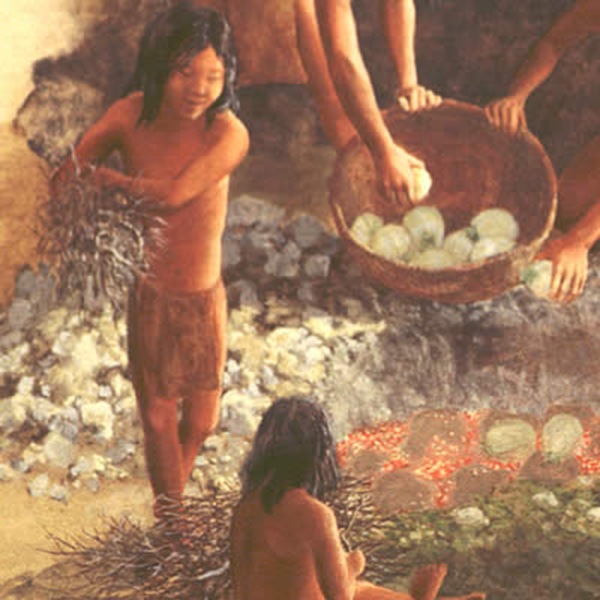What's Cookin' at Honey Creek?

Download lesson plan and included materials
Subject: Texas History
Grade: 4th. Can be adapted to 7th.
Author: Carol Schlenk (2005), revised by Jason Terry (2023)
Time Duration: 45 minutes
Overview: This lesson introduces students to the process of prehistoric hot rock cooking in earth ovens on the Edwards Plateau of Texas.
Objective: Students will:
1. Make inferences about hot rock cooking
2. Identify the Edwards Plateau geographic region
3. Sequence steps in the hot rock cooking process
4. Relate prehistoric cooking techniques to modern ones
5. Plan a menu of ancient native foods
TEKS: Social Studies, 4th grade
- (1B), identify and compare the ways of life of American Indian groups in Texas before European exploration such as the Lipan Apache, Karankawa, Caddo, and Jumano
- (1C), describe the cultural regions in which American Indians lived such as Gulf, Plains, Puebloan, and Southeastern
- (7A), explain the geographic factors such as landforms and climate that influence patterns of settlement and the distribution of population in Texas, past and present
- (8B), explain reasons why people have adapted to and modified their environment in Texas, past and present, such as the use of natural resources to meet basic needs
- (19B), analyze information by applying absolute and relative chronology through sequencing, categorizing, identifying cause-and-effect relationships, comparing, contrasting, finding the main idea, summarizing, making generalizations and predictions, and drawing inferences and conclusions
Materials:
- Honey Creek Map (included)
- Hot Rock Cooking Painting (included)
- What's Cookin' at Honey Creek? student handout (2 pages) (included)
- Internet access for What's For Dinner?: https://www.texasbeyondhistory.net/kids/dinner/index.html
Activities and Procedures:
Step 1: Introduce students to the Edwards Plateau region of Texas where the Honey Creek archeological site is located by displaying the Honey Creek Map. Point out that the Honey Creek site is in the Edwards Plateau region of Texas, an area of limestone hills and many creeks.
Step 2: Inform students that the Honey Creek site was visited intermittently by prehistoric nomadic hunting and gathering peoples from Late Paleoindian times (around 7,000 B.C., or 9,000 years ago) to historic times. Point out that these groups of Native Americans were not yet, for the most part, organized into the familiar tribes we know today, such as the Apache and Comanche.
Step 3: Display the Hot Rock Cooking Painting. Have students point out details that they notice in the painting, and then make inferences using those details. (A detail might be that a native woman is holding rocks, the inference would be why she is holding rocks.)
Step 4: Distribute the What's Cookin' at Honey Creek? student handout. Read page 1 of it aloud with students.
Step 5: Have students complete page 2 of the handout, using the Texas Beyond History exhibit, What's for Dinner?: https://www.texasbeyondhistory.net/kids/dinner/index.html
Student Product: Completed 'What's Cookin' at Honey Creek?' student handout.
Closure: Ask students to list as many modern cooking methods as they can. Answers may include gas and electric stoves, microwaves, convection ovens, gas and charcoal grills, toasters, etc. Then ask them to predict how foods might be cooked 100 years from now. 1,000 years from now? Discuss what types of modern foods could be cooked using hot rocks like the natives at Honey Creek did.
Extension Activities:
1. Explore the rest of the 'What's for Dinner?' exhibit: http://www.texasbeyondhistory.net/kids/dinner/index.html
2. Have students use the food wheel to create a menu for an ancient dinner using foods available to natives in the past. See who can come up with the most interesting menu! Allow students to share with the class, either verbally or by writing/drawing out the menu. To go further, have them choose a modern food that is the closest match to the ancient food.
3. Learn more about burned rock middens at the Camp Bowie site: http://www.texasbeyondhistory.net/bowie/index.html
Assessment: Have students read their sequencing answers aloud and check each other's work. The correct answers are in the following sequence: 5,4,9,6,2,10,1,7,3,8.